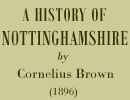< Previous | Contents | Next >
Owthorpe and Langar
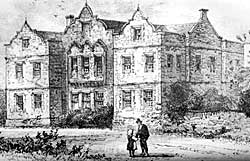
Owthorpe Hall in the early-19th century.
From Wiverton a ride through Tithby and Cropwell Butler—once the property of the Butler family—brings us to another village which possesses associations of more than ordinary importance. Owthorpe, consisting of a small cluster of houses in a secluded position near the Leicestershire border, was once the home of the Hutchinsons, of whom Colonel John Hutchinson, the regicide, was one of the most prominent and active of the Parliamentary officers.
The church is a quaint little edifice, containing monuments of the Hutchinsons; and in the field adjoining it may be clearly discerned the site which the old Hall occupied. The inhabitants are familiar with many of the details of Colonel Hutchinson’s life, and will point out the fish-pond which he constructed, and the avenue of trees still remaining which was planted in his lifetime. There are few students of history to whom the name of Colonel Hutchinson is not familiar, for the life of him, by his widow—which has passed through many editions—has long been regarded as one of the most attractive narratives of personal adventure during the great Civil War. The Hutchinsons resided some time at Cropwell, but Sir Thomas Hutchinson removed his dwelling to Owthorpe, which is about two miles away. He married the Lady Margaret, one of the daughters of Sir John Byron, of Newstead, and John Hutchinson, his son, was born at Nottingham, where the family had removed on account of a great drought in 1616. He was appointed Governor of Nottingham Castle, and after assisting in many military expeditions in the county, he was elected a member of Parliament in 1646. In the court which was formed for the trial of Charles I. Hutchinson sat as one of the judges, and his name appears thirteenth on the death-warrant which consigned the monarch to the scaffold. He built a new and more convenient house at Owthorpe, and in place of the old church—which was tolerably large—erected the present one, which is built up to the north wall of the ancient chancel.
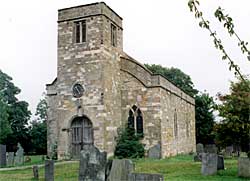
St Margaret's Church, Owthorpe was partly rebuilt c.1630-1650.
At the Restoration, when those who had participated in the death of the King were apprehended and punished, Mrs. Hutchinson addressed a letter in her husband’s name to the House, which is still preserved among the State Papers. He promised to abide the commands of the House, and begged release on parole for the sake of his miserable family.
The petition was so far acceded to that the Colonel remained at liberty until 1663, and spent a good deal of his time in opening springs, planting trees, and dressing his plantations. In 1663, information was conveyed to the Government that an insurrection was about to break out, and Hutchinson was arrested on a charge of being concerned in it. He was imprisoned in the Tower and in Sandown Castle, Kent, where he was seized with illness and died in 1664. His body was conveyed for interment to Owthorpe, where a monumental tablet was placed to his memory.
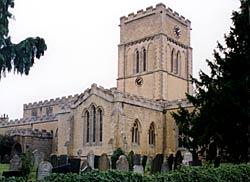 The church of St Andrew, Langar, was "unfortunately
so vigorously restored in the 1860s by the Rev. Thomas Butler that
little of the original surface remains" (Pevsner, 1981).
The church of St Andrew, Langar, was "unfortunately
so vigorously restored in the 1860s by the Rev. Thomas Butler that
little of the original surface remains" (Pevsner, 1981).In St. Paul’s Cathedral is a stately memorial erected in honour of Admiral Earl Howe; but few who read of the gallant deeds performed by this brave seaman know that his remains rest in the peaceful little Nottinghamshire village of Langar. Nevertheless, the name of Howe has long been connected with the locality, and in the parish church is the family resting-place. Langar and Barnstone lie on the Leicestershire border, and are easily accessible from the railway running hard by.
The sacred edifice, which is a very fine one, has been restored, and the south transept contains many monuments to the Howes and their predecessors, the Scropes; while in the north are memorials to the Chaworths, ancient owners of Wiverton.
Let us go back to the fourteenth century, and briefly trace the history of these noble families. Langar had been in the possession of the Tibetots several generations, when, in 1372, Robert de Tibetot died, leaving behind him three daughters, the eldest of whom, Margareta, married Roger le Scrope. Edward III. had given the custody of the deceased Baron’s lands, till the young ladies came of age, to Richard le Scrope, first Baron Scrope of Bolton, King’s Chancellor, and Keeper of the Great Seal. It is not surprising, therefore, that a match should have been arranged between the heiress and Roger, son of her guardian. From this alliance sprang many notable men, who became Knights of the Garter, and occupied high State positions. Leland speaks of their house in 1540 as a large one built of stone. There is a splendid tomb in Langar Church, where lie buried the remains of Thomas, Lord Scrope, who died in 1609, and his wife and son. Emanuel Scrope became Earl of Sunderland, and married Elizabeth, daughter of the Earl of Rutland, but dying without children by his wife, he settled Langar and the rest of his estate upon his natural issue by Martha Janes, one of whom, Annabella, married John Howe, second son of Sir John Howe, of Compton, in Gloucestershire.
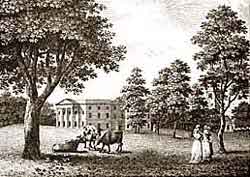
The Georgianised west front of Langar Hall with its pedimented portico and six Ionic pillars as it looked in the 1790s. Most of this building was dismantled in the 1820s and replaced with the present plain, stuccoed house in 1828.
In this way the illustrious family of Howe became connected with Langar. The first to take up his residence here was so distinguished in the service of Charles II. that the monarch gave patents of precedency to Annabella as the daughter of an Earl, and she was afterwards known as the Lady Annabella Howe. In 1701, Scrope Howe, son of this couple who allied the two ancient houses, after representing Nottingham in Parliament, was created Baron Glenawley and Viscount Howe. Succeeding him was Emanuel Scrope, Viscount Howe, and George Augustus, third Viscount, a Brigadier in the American War, who was killed in 1758.
But it was the brother of this brave soldier who has made the name of Howe most famous in history. Richard succeeded to the patrimony at Langar, and his naval achievements are conspicuous among the deeds of daring which stud the annals of England. At fourteen years old he became a midshipman, at twenty he was given the command of a sloop, and having beaten two French vessels, was made post-captain for his skill. After a series of brilliant services, he returned home and married, in 1758, Mary, the daughter of Chiverton Hartopp, Esq., of Welby, Leicestershire, and in the same year, on his brother’s death, he succeeded to the estates.
The hero was not long at home, for in 1770 he proceeded to the Mediterranean with the rank of Rear-Admiral, and in the war with France he again saw active service, and was made a Viscount of Great Britain by the title of Howe of Langar, the peerage having been hitherto an Irish one. Honours now fell fast upon him. After the relief of Gibraltar he was made First Lord of the Admiralty, and was created an Earl.
There was still work for the great seaman to do, and in the long war with France his victories in the Channel raised the enthusiasm of his countrymen. Nottinghamshire especially signalized its pride at the success of one of its noblemen, and subscriptions for the wounded were eagerly raised. The Newark Society for the Relief of the Widows and Children of Soldiers and Sailors sent fifty guineas for this purpose to Earl Howe, and to a flattering letter which accompanied the gift his lordship sent a characteristic reply.
The much-coveted Order of the Garter was conferred upon the naval victor, but he did not long survive his retirement from active duty. Gout was more disastrous to him than the squadrons of the French, and he died on August 5, 1799. As we have said before, the great Earl Howe was buried in the family vault at Langar, and a plain tablet of marble is erected to his memory. His Countess and daughter died the following year, and are commemorated in the same monumental inscription.
The noble Admiral’s successor sold Langar to John Wright, Esq., and his son demolished the old Hall. The park was divided into fields, and other modern alterations effected. A younger brother of the Earl’s, Lieutenant-Colonel (afterwards General) Sir William Howe, represented Nottingham in Parliament.
